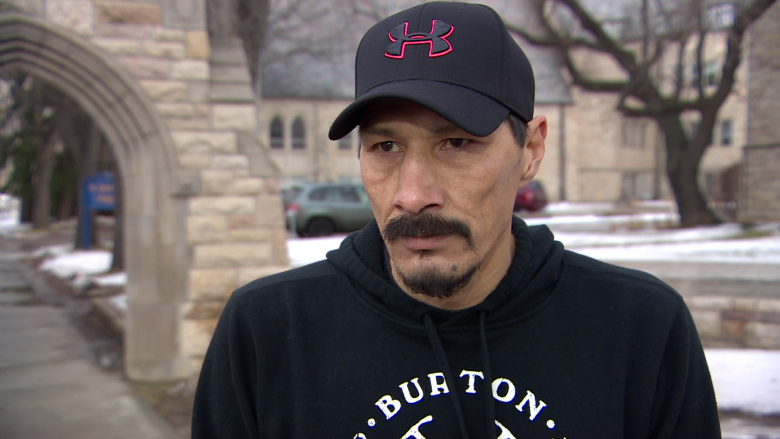Plane crash survivors took half an hour to pry open emergency exit
Arson Fern had a feeling something was wrong when the ATR 42 airplane he and his family were on starting dipping from side to side.
"I yelled in our language, in Dene, I said 'We're gonna crash! The plane's gonna crash!'"
His wife, Janey, turned to him.
"She said 'Arson, what is wrong with you?' And at 'you' — bang! — that's when it crashed."
There were 25 people on board when the plane came down near Fond-du-Lac, in northern Saskatchewan late Wednesday, Dec. 13.
No one was killed. But Fern and his wife suffered minor injuries and their son, Arson Jr., 19, is in critical condition at Saskatoon's Royal University Hospital. The family boarded another plane hours after the crash to transport their child south.
Arson Jr. has cerebral palsy and functions at the level "of a six- or seven-year-old," according to his father.
The teenager sustained injuries to his pelvis, two broken legs, and an internal injury doctors have not been able to identify yet. He is now in a medically induced coma after undergoing 13 hours of surgery on Thursday.
'You guys, don't panic'
Fern says after the plane went down, he started to hear screams and smell fuel. He looked to his left and saw his son pinned in the mangled aircraft.
"I said 'You guys, don't panic. We have to help each other,'" said Fern.
Fern could only see half Arson Jr.'s body. His wife, Janey, stayed with their son to calm him. She remained even after most of the other passengers had escaped the aircraft.
Meanwhile, Fern took off his snowpants and sweater, and climbed from his seat at the front of the plane, past people who were pinned and injured, to a hole in the wreckage, and finally made it to the emergency exit at the rear of the aircraft.
It took half an hour and four relatively uninjured people to wrench open the door.
Then, one by one, the trapped passengers "fell out of the aircraft — no energy," according to Fern.
The other exits were inaccessible, or would not open.
"These doors, I don't know, I think they failed, to me," he said.
Flight recorders recovered
Investigators will analyze two recorders to figure out what happened onboard the plane, which crashed shortly after taking off from a small airport
The 50-passenger plane is required to carry a cockpit voice recorder and a flight data recorder, according to a spokesperson with the Transportation Safety Board (TSB).
The recorders will give investigators a more detailed account of what happened.
The voice recorder captures conversation between the flight crew, as well as communication with air traffic control. It also records any ambient sounds in the cockpit or aural warnings, as well as the speed of the propellers.
The flight data recorder works alongside different sensors on the aircraft, said the safety board.
The sensors record the aircraft performance measurements, such as the power settings of engines, the speed propellers were turning and what the flight control configurations were. It can also record how the pilots were using the flight controls.
Neither captures video, however.
The TSB said it will interview the pilots and other people on board as soon as possible.
Investigators from the safety board's bureau in Winnipeg arrived at the scene of the crash Thursday afternoon to start assessing the situation and begin collecting data.
It could take up to a year or so to know what happened.
"If we do uncover any serious safety deficiencies during the course of the investigation, we're not going to wait — we'll report on those publicly," J.P. Regnier, a senior investigator with the board's air branch, said Thursday.
'A significant process'
The lengthy timeline for the investigation makes sense, according to Michael Poole, a former investigator with the TSB, now chief executive of Ottawa-based Plane Sciences Inc.
The company helps governments around the world develop technology capabilities to analyze data from flight records.
Poole said the flight data information comes in as a complicated format that is essentially ones and zeros.
"It's a significant process to turn the data into meaningful information, and that process, to quote the United States NTSB colleague of mine many years ago, is fraught with opportunity for error," Poole said.
Investigators spend months reviewing the data and turning it into computer reconstructions of the crash. The audio recordings are also completely transcribed.
"You kind of have like a movie almost of what happened. It's almost like being there, sitting in the background, watching it unfold," he said.
Interviews with passengers and crew will also be conducted, but Poole said the flight recorders are more objective and factual.
"People aren't good flight recorders, just in general. Lots of psychology at play, and what people remember and perceive happened and what really happened can be quite different."
The black boxes are built to withstand impact, according to Poole, but are susceptible to fire damage. He predicted the recordings from the Fond-du-Lac crash would be in good condition.
On Friday, the safety board tweeted that the two recorders and an emergency locator transmitter were recovered and secured.
Poole said investigators may have a good idea early on what caused the crash, but only a thorough review will give the full answer.
"It's a complex process and they want to make sure they get that right, they don't want to put out data that's not correct," he said.




